

Temples

The first major Hindu reference to Sri Lanka is found in the epic Ramayana. Sri Lanka was ruled by the Yaksha King Kubera. The throne of Lanka was usurped by Kubera’s half-brother Ravana, the epic’s chief antagonist, who was killed by Rama (the seventh avatar of Vishnu). The Ramayana also mentions Rama’s Bridge, between India and Sri Lanka, which was built with rocks by Rama with the aid of Hanuman and others. Many believers see the chain of sandbars, connecting Sri Lanka to India in satellite images, as remnants of the bridge. Archaeological evidence supports the worship of Siva in parts of Sri Lanka since prehistoric times, before the arrival of Prince Vijaya. Ravana was also a devotee of Siva.
Evidence indicates that the island’s earliest inhabitants were the Nagas and Yakkas. The Nagas practised an early form of Hinduism, worshipping Shiva and serpents. This animistic Shaivism is also common in Tamil Nadu and other parts of India.The Nagas who inhabited the Jaffna Peninsula were probably the ancestors of Sri Lankan Tamils. They began absorbing the Tamil language and culture during the 3rd century BC, and lost their separate identity.The Nainativu Nagapooshani Amman Temple in Nainativu is believed to be one of the Shakti Peetha.
Buddhism was introduced by Mahinda, the eldest son of Ashoka, during the reign of Devanampiya Tissa of Anuradhapura.The Sinhalese embraced Buddhism, and the Tamils remained Hindus.Activity from across the Palk Strait in Tamil Nadu set the stage for Hinduism’s survival in Sri Lanka. Shaivism (worship of Shiva) was dominant among the Tamils, and most of Sri Lanka’s Hindu temple architecture and philosophy of Sri Lanka drew from that tradition. Thirugnana Sambanthar noted a number of Sri Lankan Hindu temples in his works.
In common with South India, local rituals include Kavadi Attam and firewalking.These rituals have also influenced the Sinhalese on southern cost of the island; For an Instance, the inhabitants of Tangalle, Kudawella and the surrounding area perform Kavadi.
Religious teachers include Kaddai Swami, his shishya Chellappaswami, and
Chellappaswami’s shishya Yogaswami.
The Pancha Ishwarams are:
- Naguleswaram temple in the north
- Ketheeswaram temple in the northwest
- Koneswaram Temple in the east
- Munneswaram temple in the west
- Tondeswaram in the south
Naguleswaram temple
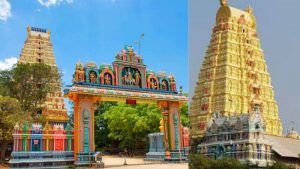
(Tamil: கீரிமலை நகுலேஸ்வரம் கோயில்), historically known also as the Thirutambaleswaram Kovil of Keerimalai, is a famous Hindu temple in Keerimalai, located north of Jaffna, Northern Province, Sri Lanka in the suburb of Kankesanthurai. One of the oldest shrines of the region, it is the northernmost of the island’s Pancha Ishwarams of Lord Siva, venerated by Hindus across the world from classical antiquity. Hindus believe its adjacent water tank, the Keerimalai Springs, to have curative properties, which irrigation studies attribute to high mineral content sourced from underground Keerimalai is 50 feet above sea level, and situated west of Palaly. Hindus flock in large numbers on Aadi Amaavaasai day which falls during the Tamil month of Aadi, to carry out rituals for their forefathers and bathe in the natural springs. Carried out largely by men, “Keerimalai” is particularly famous for this festival.
The temple was largely destroyed by Jesuit missionaries following the Portuguese conquest of the Jaffna kingdom, restored by Arumuka Navalar in 1894, was occupied by the Sri Lankan Army in 1983 and bombed by the Sri Lankan Air Force in 1993. After nearly twenty years, a major expansion and reopening of the temple occurred in 2012.
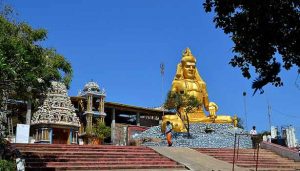
Ketheeswaram temple (Tamil: திருக்கேதீஸ்வரம் Tirukkētīsvaram) is an ancient Hindu temple in Mannar, Northern Province Sri Lanka. Overlooking the ancient Tamil port towns of Manthai and Kudiramalai, the temple has lain in ruins, been restored, renovated and enlarged by various royals and devotees throughout its history. Tirukkētīsvaram is one of the Pancha Ishwarams dedicated to the Hindu deity Shiva and is venerated by Shaivas throughout the continent. Throughout its history, the temple has been administered and frequented by Sri Lankan Hindu Tamils. Its famous tank, the Palavi tank, is of ancient antiquity and was restored from the ruins. Tirukkētīsvaram is one of the 275 Paadal Petra Sthalams of
Shiva glorified in the poems of the Tevaram.
Literary and inscriptional evidence of the post classical period (300BC-1500AD) attests to the upkeep of the temple during the ancient period by kings of the Pallava, Pandyan Dynasty and Chola dynasties who contributed to its development up to the late 16th century. In 1575, Tirukkētīsvaram was largely destroyed by Portuguese colonials, with Pujas terminating at the shrine in 1589. Following an appeal by Arumuka Navalar in 1872, the temple was rebuilt at its original site in 1903.
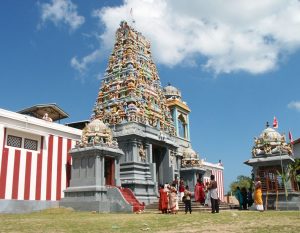
Koneswaram temple of Trincomalee (Tamil: திருக் கோணேச்சரம் கோயில்) or Thirukonamalai Konesar Temple – The Temple of the Thousand Pillars and Dakshina-Then Kailasam is a classical-medieval Hindu temple complex in Trincomalee, a Hindu religious pilgrimage centre in Eastern Province, Sri Lanka. The most sacred of the Pancha Ishwarams of Sri Lanka, it was built significantly during the reign of the early Cholas and the Five Dravidians of the Ear Pandyan Kingdom atop Konesar Malai, a promontory overlooking Trincomalee District, Gokarna bay and the Indian Ocean. Its Pallava, Chola, Pandyan and Jaffna design reflect a continual Tamil Saivite influence in the Vannimai region from the classical period. The monument contains its main shrine to Shiva in the form Kona-Eiswara, shortened to Konesar. Connected at the mouth of the Mahavilli Ganga River to the footprint of Shiva at Sivan Oli Padam Malai at the river’s source, the temple symbolically crowns the flow of the Ganges River from Shiva’s head of Mount Kailash to his feet.
Developed from 205 BC, the original kovil combined key features to form its basic Dravidian temple plan, such as its thousand pillared hall – “Aayiram Kaal Mandapam” – and the Jagati expanded by King Elara Manu Needhi Cholan. Regarded as the greatest building of its age for its architecture, elaborate sculptural bas-relief ornamentation adorned a black granite megalith while its multiple gold plated gopuram towers were expanded in the medieval period. One of three major Hindu shrines on the promontory with a colossal gopuram tower, it stood distinctly on the cape’s highest eminence.
The journey for pilgrims in the town begins at the opening of Konesar Road and follows a path through courtyard shrines of the compound to the deities Bhadrakali, Ganesh, Vishnu Thirumal, Surya, Raavana, Ambal-Shakti, Murukan and Shiva who presides at the promontory’s height. The annual Koneswaram Temple Ther Thiruvilah festival involves the Bhadrakali temple of Trincomalee, the Pavanasam Theertham at the preserved Papanasuchunai holy well and the proximal Back Bay Sea (Theertham Karatkarai) surrounding Konesar Malai Although the primary benefactors of the temple have been Sri Lankan Tamil people, a number of Sinhalese pilgrims have worshipped at the temple. The settlement of Kantalai was home to many of its devotees.
The complex was destroyed in colonial religious attacks between 1622 and 1624 and a fort was built at the site from its debris. A 1632 built temple located away from the city houses some of its original idols. Worldwide interest was renewed following the discovery of its underwater and land ruins, sculptures and Chola bronzes by archaeologists and Arthur C. Clarke. It has been preserved through restorations, most recently in the 1950s. Granted ownership of villages in its floruit
to form the Trincomalee District, Trincomalee village is located on the cape isthmus within the compounds. Revenue from the temple provides services and food to local residents.
Koneswaram has many strong historical associations. The shrine is described in the Vayu Purana, the Konesar Kalvettu and Tevaram hymns by Sambandhar and Sundarar as a Paadal Petra Sthalam along with its west coast Ishwaram counterpart Ketheeswaram temple, Mannar, and was praised for its tradition by Arunagirinathar upon his visit. The Dakshina Kailasa Puranam and Manmiam works note it as Dakshina/Then Kailasam (Mount Kailash of the South) for its longitudinal position and pre-eminence, it lies directly east of Kudiramalai west coast Hindu port town, while it is the easternmost shrine of the five ancient Ishwarams of Shiva on the island.
Mentioned as a widely popular bay temple of the island in the Mahabharata, Ramayana and Yalpana Vaipava Malai, the Mattakallappu Manmiam confirms its sacred status for all Hindus. Kachiyappa Sivachariar’s Kanda Puranam compares the temple to Thillai Chidambaram Temple and Mount Kailash in Saivite esteem. Konesar Malai may have been the site where Yoga originated; some scholars have suggested that the worship of the almighty god Eiswara on the promontory is the most ancient form of worship existing.
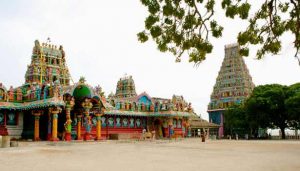
Munneswaram temple (Sinhala: Tamil: முன்னேசுவரம் கோயில்) is an important regional Hindu temple complex in Sri Lanka. It has been in existence at least since 1000 CE although myths surrounding the temple associate it with the popular Indian epic Ramayana, and its legendary hero-king Rama. The temple is one of the ancient Pancha Ishwarams dedicated to Shiva in the region.
The temple complex is a collection of five temples, including a Buddhist temple. The central temple dedicated to Shiva (Siva) is the most prestigious and biggest, and is popular amongst Hindus. The other temples are dedicated to Ganesha, Ayyanayake and Kali. The Kali temple is also popular with Buddhists, who frequent the complex. Post-19th century, most of the devotees of all temples in the complex belong to the majority Sinhala Buddhist ethnic group; the temples, excluding the Ayyanayake and the Buddhist temple, are administered by families belonging to the minority Hindu Tamils.
The temple is located in Munneswaram, a village with mixed Sinhala and Tamil population situated in the historic Demala Pattuva (“Tamil division”) region in the Puttalam District. The main Shiva temple owns extensive property in the surrounding villages, ownership of which was affirmed when the region was part of the medieval Kotte Kingdom. The temple was destroyed twice by the Portuguese colonial officers, who handed over the properties to the Jesuits. Although the Jesuits built a Catholic chapel over the temple foundation, locals reconstructed the temple both times. Due to religious and demographic change after the late 18th century, most surrounding villages and towns are not directly associated with the temple administration and maintenance. However, the villages of Maradankulama and Udappu are associated with organizing the main temple festival.
The main festivals celebrated at the temple include Navarathri and Sivarathri. The former is a nine-day long festival in honour of the presiding Goddess, while the latter is an overnight observation in honour of Lord Shiva. In addition to these two Hindu festivals, the temple has a festival of its own, the Munneswaram festival, a four-week-long event attended by Hindus and Buddhists.
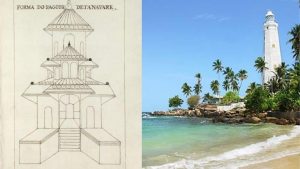
Tenavaram temple (Tamil: தென்னாவரம் கோயில்) (historically known as the Tenavaram Kovil, Tevanthurai Kovil or Naga-Risa Nila Kovil) was a historic Hindu temple complex situated in the port town Tenavaram, Tevanthurai (or Dondra Head), Matara) near Galle, Southern Province, Sri Lanka. Its primary deity was a Hindu god Tenavarai Nayanar (Upulvan) and at its zenith was one of the most celebrated Hindu temple complexes of the island, containing eight major kovil shrines to a thousand deity statues of stone and bronze and two major shrines to Vishnu and Shiva. Administration and maintenance was conducted by residing Hindu Tamil merchants during Tenavaram’s time as a popular pilgrimage destination and famed emporium employing over five hundred devadasis.
The complex, bordered by a large quadrangle cloister, was a collection of several historic Hindu Kovil shrines, with its principle shrine designed in the Kerala and Pallava style of Dravidian architecture. The central temple dedicated to Vishnu (Tenavarai Nayanar) known as Upulvan to the Sinhalese was the most prestigious and biggest, popular amongst its large Tamil population, pilgrims and benefactors of other faiths such as Buddhism, kings and artisans. The other shrines that made up the Kovil Vatta were dedicated to Ganesh, Murukan, Kannagi and Shiva, widely exalted examples of stonework construction of the Dravidian style. The Shiva shrine is venerated as the southernmost of the ancient Pancha Ishwarams of Lord Shiva (called Tondeswaram), built at coastal points around the circumference of the island in the classical period. Tenavaram temple owned the entire property and land of the town and the surrounding villages, ownership of which was affirmed through
several royal grants in the early medieval period. Its keepers lived along streets of its ancient agraharam within the complex. Due to patronage by various royal dynasties and pilgrims across Asia, it became one of the most important surviving buildings of the classical Dravidian architectural period by the late 16th century. The temple compound was destroyed by Portuguese colonial Thome de Sousa d’Arronches, who devastated the entire southern coast. The property was then handed over to Catholics. Tenavaram’s splendor and prominence ranked it in stature alongside the other famous Pallava-developed medieval Hindu temple complex in the region, Koneswaram of Trincomalee. Excavations at the complex mandapam’s partially buried ruins of granite pillars, stairs and slab stonework over the entire town have led to numerous findings. Reflecting the high points of Pallava artistic influence and contributions to the south of the island are the temple’s 5th- to 7th-century statues of Ganesh, the Lingam, sculpture of Nandi and the Vishnu shrine’s 10th-century Makara Thoranam (stone gateway), the frame and lintel of which include small guardians, a lustrated Lakshmi, dancers, musicians, ganas, and yali-riders.
Tenavaram temple was built on vaulted arches on the promontory overlooking the Indian Ocean. The central gopuram tower of the vimana and the other gopura towers that dominated the town were covered with plates of gilded brass, gold and copper on their roofs. Its outer body featured intricately carved domes, with elaborate arches and gates opening to various verandas and shrines of the complex, giving Tenavaram the appearance of a golden city to sailors who visited the port to trade and relied on its light reflecting gopura roofs for navigational purposes.